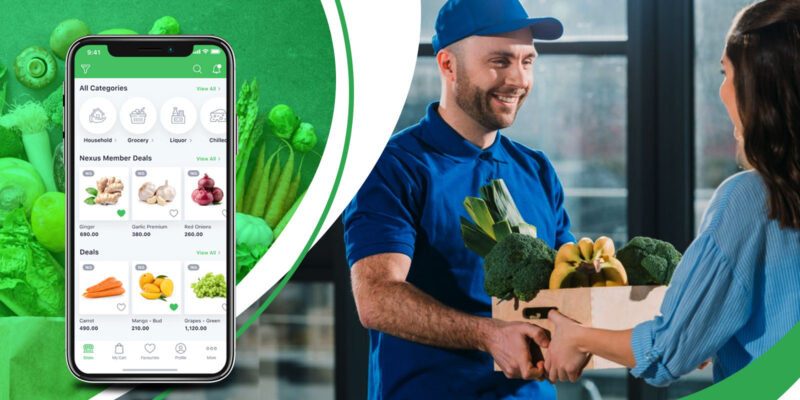
The advent of the digital era has revolutionized many aspects of daily life, with the grocery delivery sector undergoing significant transformation. Instacart, a leading name in this industry, has set a benchmark for online grocery shopping and delivery. However, with its success, a wave of Instacart clones has emerged, each striving to capture a share of the burgeoning market. This guide delves into the rise of these Instacart clones, exploring their impact on consumer convenience, the technologies driving their success, and the challenges they face in a competitive landscape. Additionally, we highlight the best Instacart clone app, examining its features, user experience, and market reception.
The Evolution of Grocery Delivery
Grocery delivery is not a novel concept; it has roots dating back to the early 20th century when local grocers would deliver orders to nearby residents. However, the model remained relatively unchanged for decades, primarily serving a small segment of the population. The digital revolution of the 21st century, coupled with the proliferation of smartphones, paved the way for a more sophisticated approach to grocery delivery.
Instacart, founded in 2012, capitalized on this shift by offering a platform where customers could order groceries online from a variety of local stores and have them delivered within hours. Its success has inspired numerous clones, each aiming to replicate and improve upon its model.
What are Instacart Clones?
Instacart clones are grocery delivery platforms modeled after Instacart’s business model. They offer similar services, enabling users to order groceries online from multiple stores and have them delivered to their doorstep. These clones leverage advanced technology to streamline operations, enhance user experience, and expand market reach.
Key features of Instacart clones include:
- User-Friendly Interface: Intuitive design for easy navigation and ordering.
- Wide Selection of Stores: Partnerships with various local and national retailers.
- Real-Time Inventory: Up-to-date product availability and pricing.
- Personal Shoppers: Dedicated individuals who handpick items for each order.
- Fast Delivery: Options for same-day or scheduled delivery.
Technologies Powering Instacart Clones
The success of Instacart clones hinges on their ability to integrate cutting-edge technologies. Several key innovations drive their efficiency and popularity:
- Artificial Intelligence (AI) and Machine Learning (ML): These technologies are used to predict consumer behavior, optimize delivery routes, and personalize recommendations. AI algorithms analyze purchasing patterns to suggest products and create more efficient shopping lists.
- Real-Time Data Analytics: Real-time analytics enable platforms to track inventory, monitor delivery status, and provide live updates to customers. This ensures transparency and reliability in the service.
- Mobile Applications: Robust mobile apps facilitate easy ordering and tracking. Features such as push notifications, barcode scanning, and voice search enhance user convenience.
- GPS and Mapping Services: GPS technology is crucial for accurate delivery tracking and route optimization, reducing delivery times and operational costs.
- Payment Integration: Secure and versatile payment gateways support various payment methods, ensuring seamless transactions.
- Cloud Computing: Cloud-based infrastructure supports scalability, data storage, and real-time processing, essential for handling large volumes of transactions.
The Impact on Consumer Convenience
Instacart clones have significantly enhanced consumer convenience in several ways:
- Time-Saving: Customers can shop for groceries from the comfort of their homes, saving time otherwise spent traveling and shopping in stores.
- Accessibility: These platforms offer access to a wide range of products from multiple stores, including specialty items that may not be available locally.
- Personalized Shopping Experience: Advanced algorithms provide personalized recommendations, making it easier for customers to find and purchase their preferred products.
- Flexibility: Options for same-day delivery and flexible scheduling accommodate busy lifestyles and last-minute needs.
- Safety and Hygiene: Particularly in the wake of the COVID-19 pandemic, grocery delivery services minimize exposure to crowded places, enhancing safety and hygiene for consumers.
Market Expansion and Competition
The grocery delivery market has seen exponential growth, driven by changing consumer preferences and technological advancements. Several players have entered the field, each vying for market share. Key competitors include:
- Amazon Fresh: Leveraging Amazon’s vast logistics network, Amazon Fresh offers a comprehensive grocery delivery service with competitive pricing and fast delivery times.
- Walmart Grocery: Walmart’s extensive retail presence and robust supply chain enable it to offer reliable grocery delivery services, often with no membership fees.
- Shipt: Owned by Target, Shipt provides same-day delivery from various retailers, emphasizing speed and customer service.
- DoorDash: Originally a food delivery service, DoorDash has expanded into grocery delivery, offering a familiar interface and reliable service.
These competitors, along with numerous regional and niche players, contribute to a dynamic and highly competitive market. Each platform strives to differentiate itself through unique features, loyalty programs, and strategic partnerships.
Challenges Faced by Instacart Clones
Despite their rapid growth, Instacart clones face several challenges:
- Logistics and Scalability: Managing a vast network of stores, personal shoppers, and delivery personnel requires sophisticated logistics and significant investment in infrastructure.
- Customer Retention: With numerous options available, retaining customers requires exceptional service, competitive pricing, and continuous innovation.
- Regulatory Compliance: Navigating the regulatory landscape, particularly concerning labor laws and data privacy, is crucial for sustainable operations.
- Profitability: Achieving profitability can be challenging due to high operational costs and the need for continuous investment in technology and marketing.
- Competition: Intense competition from established players and new entrants requires constant adaptation and differentiation.
Future Trends in Grocery Delivery
The future of grocery delivery is poised for continued innovation and growth. Key trends to watch include:
- Autonomous Delivery: Drones and self-driving vehicles could revolutionize last-mile delivery, reducing costs and delivery times.
- Sustainability: Eco-friendly practices, such as reducing packaging waste and optimizing delivery routes for fuel efficiency, will become increasingly important.
- Hyper-Personalization: Advanced AI will enable even more personalized shopping experiences, tailored to individual preferences and dietary needs.
- Integration with Smart Homes: Integration with smart home devices and voice assistants will streamline the ordering process, making it more convenient for consumers.
- Expansion of Services: Beyond groceries, these platforms may expand to include other household essentials and services, creating a one-stop solution for consumers.
Conclusion
The rise of Instacart clones has transformed the grocery delivery landscape, offering unparalleled convenience and accessibility for consumers. Powered by advanced technologies and driven by fierce competition, these platforms continue to innovate and evolve. While they face several challenges, the future holds immense potential for further growth and enhancement of the grocery shopping experience. As consumer expectations continue to rise, Instacart clones and their competitors will need to stay ahead of the curve, delivering exceptional value and service to remain relevant in a dynamic market.










